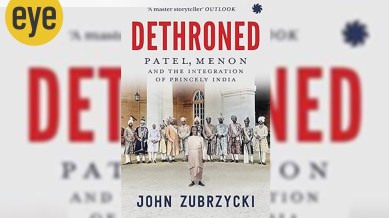John Zubrzycki’s ‘Dethroned’ traces how Sardar Patel and his deputy VP Menon prevented the balkanisation of India at the time of Independence
The book explores the extensive role the two played in the dissolution of the princely order and their accession to India

German chancellor Otto von Bismarck had to win a few wars before he could unify Germany. India’s own Bismarck, Sardar Vallabhbhai Patel, accomplished a far bigger and more complex unification before and after Independence. When his initial plans for an independent India went awry, a desperate Lord Mountbatten turned to his senior-most Indian civil servant VP Menon, giving him a single night to devise a plan for Independence. Menon met his deadline, presenting his Menon Plan which would play midwife to India’s birth as a free nation. Dethroned, John Zubrzycki’s latest offering focuses on the period 1947-50, which saw the end of the Raj and the dissolution of the princely order.
The main protagonists in this drama are Patel, who was the state’s minister, and Menon, his deputy in the state’s department. Together, they prevented the Balkanisation of India, coaxing, threatening and arm-twisting 565 princely states into acceding to India. But there were moral and legal compromises involved and promises given to the princes that were not kept. The princes thought that they were signing over rights only concerning foreign policy, communications and defence but soon, this encroached into other areas.
Nehru accused Patel of communalism and there is some substance to this charge. The annexations of Junagadh and Hyderabad were accompanied by communal violence, much of it due to calculated inaction. For his part, Patel was irked by Nehru’s reluctance to use force while dealing with Junagadh, Kashmir and Hyderabad.
When Junagadh’s ruler Mahabat Khan announced his state’s accession to Pakistan, Patel immediately recognised that this would set a precedent for Hyderabad. Not challenging the accession would give Pakistan the right to object to the Hindu ruler of Muslim-dominated Kashmir opting for India. This made him insist that India intervene militarily. Patel also clashed with Nehru over his offer to hold a plebiscite in Junagadh, calling it “unnecessary and uncalled for.” The Junagadh crisis was resolved when Khan fled to Karachi but a more serious one erupted in Kashmir when Maharaja Hari Singh refused to accede to either nation. It required Patel’s firm hand to deal with the crisis.
Field Marshal Sam Manekshaw, who was a colonel at the time, narrated how an angry Patel asked Nehru whether he wanted to keep Kashmir or give it away. When Nehru replied in the affirmative, Patel asked him to give orders to that effect. Before Nehru could say anything, Patel turned to Manekshaw and said, “You have your orders.” In Hyderabad, too, it was Patel who took the initiative to prepare for a military intervention to put an end to the state’s bid for independence. Once again, Nehru opposed using force to end the crisis.
Despite Patel’s antipathy towards the princes, he honoured his promises to them by enshrining their privy purses in the Constitution. In 1971, Indira Gandhi dealt the final blow when she abolished the privy purses. Written in engaging prose, the book holds the reader’s interest with lively anecdotes and unusual details. However, Zubrzycki’s largely stereotypical portrayal of princes as dictators given to wild excesses shows his uncritical acceptance of British portrayals of princely India. Many of the personal excesses were wild exaggerations, if not fiction, and a ploy by the British to delegitimise native authority. Zubrzycki does refer to progressive rulers but only within the old cliché-ridden framework.